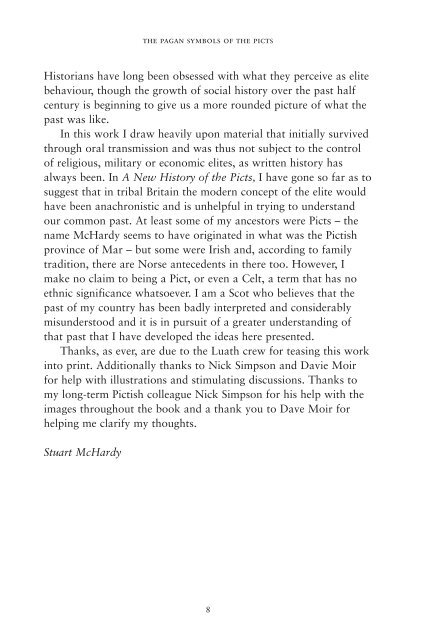Pagan Symbols of the Picts by Stuart McHardy sampler
Stuart McHardy examines the Pictish symbols which have been discovered on various items across Scotland. The book sets out a cohesive interpretation of the Pictish past, using a variety of both temporal and geographical sources. This interpretation serves as a backdrop for his analysis of the symbols themselves, providing a context for his suggestion that there was an underlying series of ideas and beliefs behind the creation of the symbols.
Stuart McHardy examines the Pictish symbols which have been discovered on various items across Scotland. The book sets out a cohesive interpretation of the Pictish past, using a variety of both temporal and geographical sources. This interpretation serves as a backdrop for his analysis of the symbols themselves, providing a context for his suggestion that there was an underlying series of ideas and beliefs behind the creation of the symbols.
Create successful ePaper yourself
Turn your PDF publications into a flip-book with our unique Google optimized e-Paper software.
<strong>the</strong> pagan symbols <strong>of</strong> <strong>the</strong> picts<br />
Historians have long been obsessed with what <strong>the</strong>y perceive as elite<br />
behaviour, though <strong>the</strong> growth <strong>of</strong> social history over <strong>the</strong> past half<br />
century is beginning to give us a more rounded picture <strong>of</strong> what <strong>the</strong><br />
past was like.<br />
In this work I draw heavily upon material that initially survived<br />
through oral transmission and was thus not subject to <strong>the</strong> control<br />
<strong>of</strong> religious, military or economic elites, as written history has<br />
always been. In A New History <strong>of</strong> <strong>the</strong> <strong>Picts</strong>, I have gone so far as to<br />
suggest that in tribal Britain <strong>the</strong> modern concept <strong>of</strong> <strong>the</strong> elite would<br />
have been anachronistic and is unhelpful in trying to understand<br />
our common past. At least some <strong>of</strong> my ancestors were <strong>Picts</strong> – <strong>the</strong><br />
name <strong>McHardy</strong> seems to have originated in what was <strong>the</strong> Pictish<br />
province <strong>of</strong> Mar – but some were Irish and, according to family<br />
tradition, <strong>the</strong>re are Norse antecedents in <strong>the</strong>re too. However, I<br />
make no claim to being a Pict, or even a Celt, a term that has no<br />
ethnic significance whatsoever. I am a Scot who believes that <strong>the</strong><br />
past <strong>of</strong> my country has been badly interpreted and considerably<br />
mis understood and it is in pursuit <strong>of</strong> a greater under standing <strong>of</strong><br />
that past that I have developed <strong>the</strong> ideas here presented.<br />
Thanks, as ever, are due to <strong>the</strong> Luath crew for teasing this work<br />
into print. Additionally thanks to Nick Simpson and Davie Moir<br />
for help with illustrations and stimulating discussions. Thanks to<br />
my long-term Pictish colleague Nick Simpson for his help with <strong>the</strong><br />
images throughout <strong>the</strong> book and a thank you to Dave Moir for<br />
helping me clarify my thoughts.<br />
<strong>Stuart</strong> <strong>McHardy</strong><br />
8


















